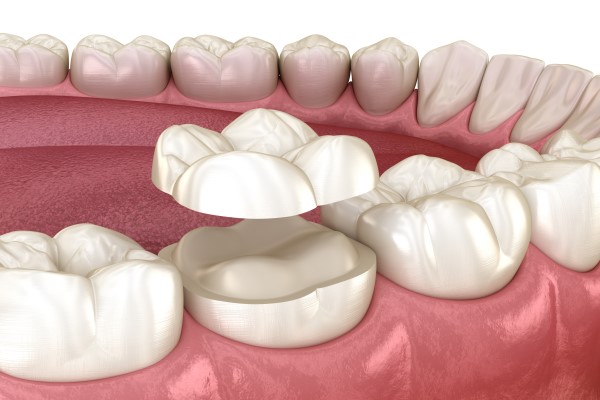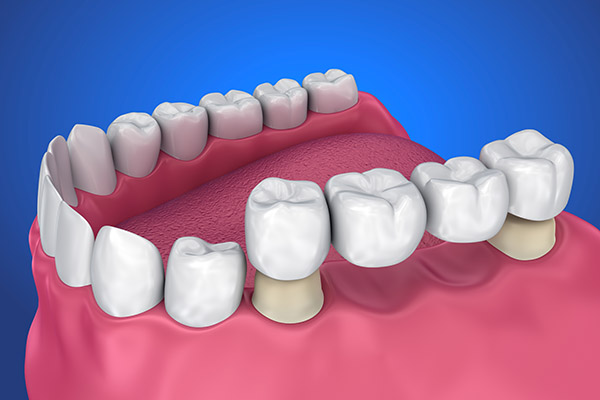Is It Possible To Whiten Dental Crowns?

Dentists use dental crowns to protect or restore damaged teeth. Sometimes, tooth decay becomes too advanced or cracking may weaken the structure of the teeth. In these cases, a dentist may suggest a crown when fillings cannot solve the issue. Crowns are caps made of various materials, including ceramic, resin, porcelain, and metal.
Crown placement is a routine procedure, but many people wonder if they can have their dental crowns whitened at a later date. The short answer is that crowns do not whiten in the same way that natural teeth do, so it is important to have them properly color matched before placement. Here is what you need to know about crowns and whitening.
The truth behind whitening and crowns
Over time, teeth change color. Coffee, red wine, and tea tend to be the worst culprits when it comes to staining. The color pigments stick to the outer part of the tooth and enamel. Additionally, age changes the colors of a patient's teeth. The teeth have a white outer shell and a yellow dentin beneath it. As the outer enamel becomes thinner, the teeth appear more yellow.
When dentists shape crowns, they choose a color based on the color of the patient's teeth. Generally, the patient's teeth may change colors around the crowns.
How teeth whitening works
Tooth whitening products contain hydrogen peroxide or carbamide peroxide. The bleach breaks the stains into smaller pieces to create a less concentrated color and to brighten the teeth. The chemicals penetrate the tooth's enamel to handle the stains. To change the color of the tooth, the bleach has to seep into the hard structure of the tooth.
To whiten teeth, patients can use stain removal toothpastes, in-office bleaching, or at-home bleaching kits. Toothpastes have mild abrasives to scrub the teeth, along with polishing agents to remove stains, but you will generally get more dramatic results at your dentist's office.
During an in-office whitening procedure, the dentist applies a rubber shield or protective gel to the gums before applying bleach to the teeth. Dentists use a heating lamp for three 20-minute intervals. At-home bleaching kits come with trays customized by the dental office for the patient's mouth. The patient receives instructions on how to apply the bleach. The process can take a few days or a few weeks.
Whitening agents cannot penetrate the crown's materials. In some cases, tooth-colored fillings can undergo whitening treatment with some success, but this is because the tooth around the filling changes color. With veneers, dentists may try to whiten the areas of exposed tooth.
How to whiten dental crowns
Color matching prior to the placement of a crown is important. If you are unhappy with the color of your teeth overall and will be needing a crown, you may want to have a whitening treatment done before getting the crown. Then, your dentist can match the color to your newly whitened teeth.
If patients want a whiter smile long after getting a crown, they can still undergo whitening treatment. Most patients do not have crowns covering all of their teeth. They can whiten the teeth around the crowns. Of course, the crown may still have stains and be a different color from the rest of the smile.
To whiten the crowns, patients have to consider replacing the crown. Dentists can whiten the teeth and then create a new crown based on the whiter smile.
Some patients have crowns for decades, and over time, the restoration becomes dingy or flat. Nowadays, crowns can be bright and white and remain that way longer. If the original color has faded, the dentist removes the crown and cleans the underlying tooth of any stains or decay. The dentist can place a new crown to match the patient's white smile.
Keep in mind, also, that regular professional cleanings can help remove surface stains from crowns as well as natural teeth. So even if whitening agents cannot penetrate the crown, a cleaning can remove stains from coffee, red wine, and other substances. The key is to get your mouth cleaned regularly at the dentist office.
Conclusion
When it comes to dental crowns, teeth whitening processes do not work because the bleaching agent cannot penetrate the exterior of the crown. While patients can whiten the teeth around the crowns, they should replace crowns after a whitening treatment if stains remain and show a significant color difference between natural teeth and crowns.
Request an appointment here: https://smilewellsouthbay.com or call SmileWell Family Dentistry at (310) 904-6375 for an appointment in our Torrance office.
Check out what others are saying about our dental services on Yelp: Dental Crowns and Dental Bridges in Torrance, CA.
Recent Posts
When a patient has a tooth that is giving them problems, general dentistry may recommend a dental crown as a potential solution. While crowns can have a reputation for being highly noticeable in the mouth, modern crowns are made from many different materials that allow them to blend in. Here is how crowns can be…
A dental crown can restore a damaged, worn, or weakened tooth. This restoration can bring back your healthy smile and stable dental function. Knowing the benefits of dental caps can motivate you to set an appointment soon. Here are the benefits of a dental crown that you must consider.Losing a tooth can be annoying, especially…
A dental crown is a way for a dentist to repair a broken or damaged tooth. This is a simple solution that many people elect because it is durable and looks like normal teeth. It is also a great option if you have only one tooth that is damaged.The crown is made to match your…
When a person is missing one or more teeth but does not need a full set of dentures, dental bridges may be recommended to take the place of the lost teeth. The number of teeth that a dental bridge replaces may depend on several factors.Dental bridges consist of two or more crowns that attach to…


